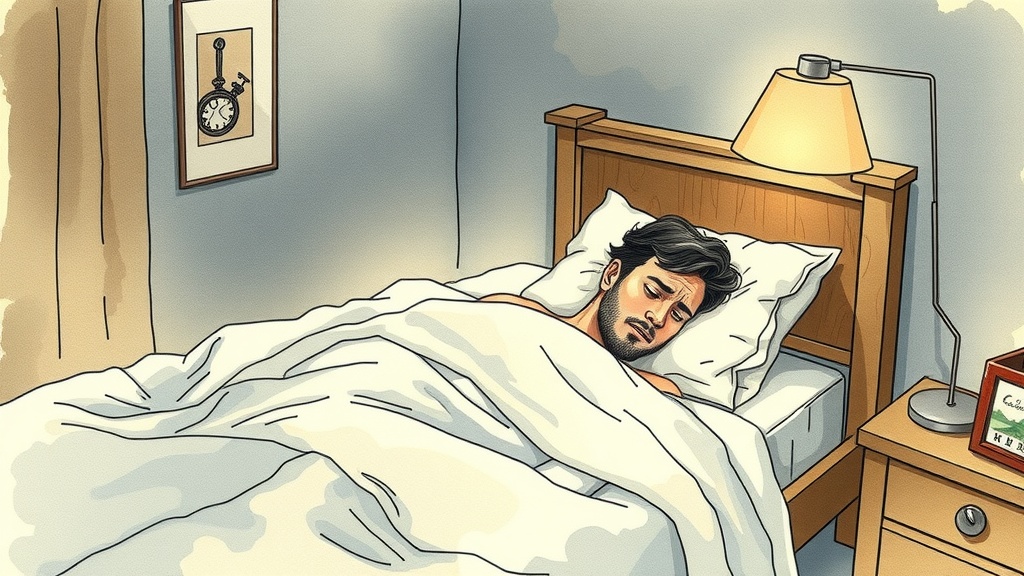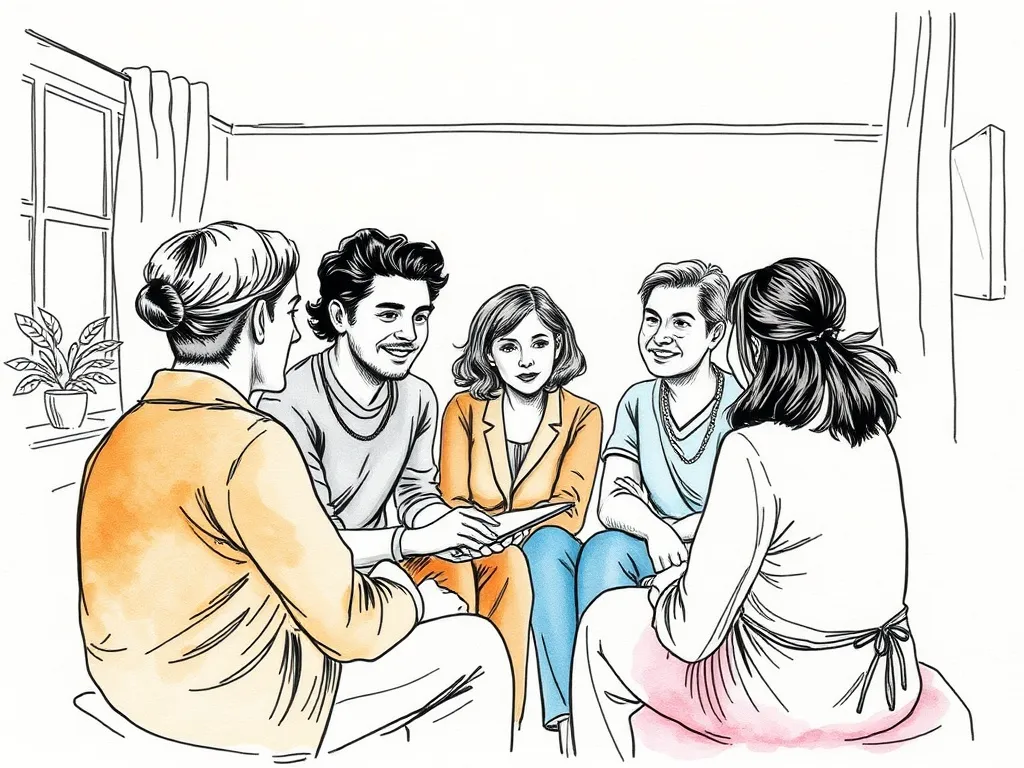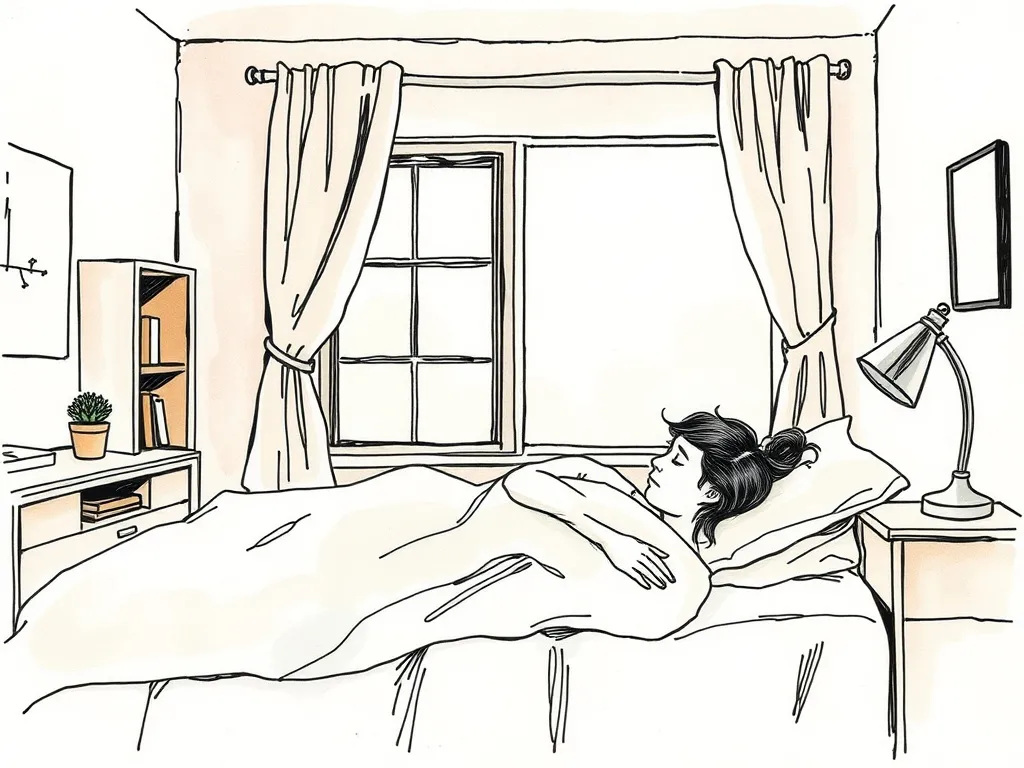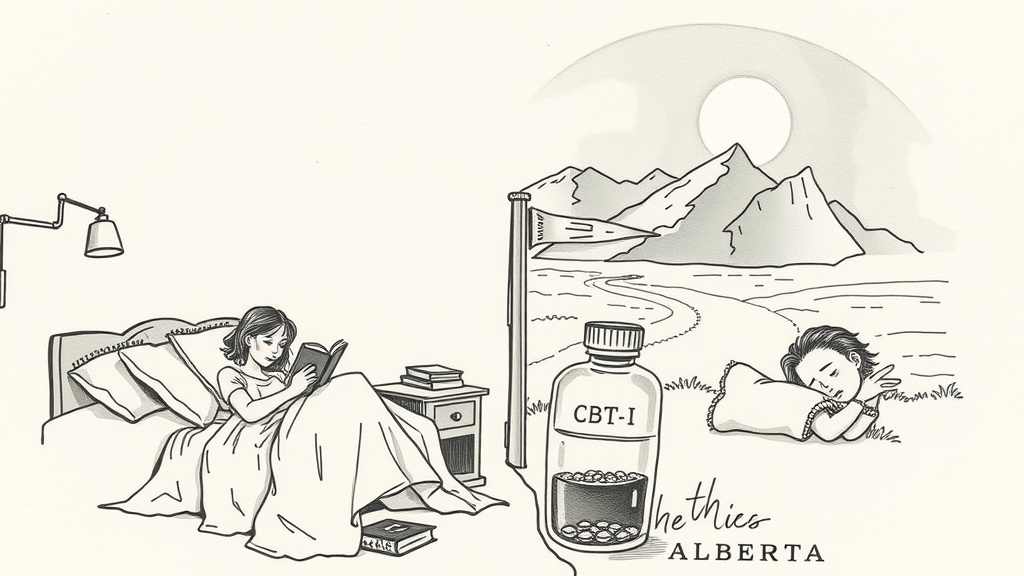· Don Schmidt · Guides · 11 min read
Breaking the Cycle: Using CBT-I to Address Anxiety-Driven Insomnia in Alberta
Discover how Cognitive Behavioral Therapy for Insomnia (CBT-I) can break the cycle of anxiety-driven sleeplessness and restore restful nights in Alberta.

Understanding the Vicious Cycle: Anxiety and Insomnia
For many Albertans, the quiet hours of the night aren’t a sanctuary of rest but a battleground for racing thoughts and persistent worry. This is the hallmark of anxiety-driven insomnia, a debilitating condition where the mind, instead of winding down, gears up, making sleep feel like an impossible feat. It’s a vicious cycle: anxiety prevents sleep, and the lack of sleep then exacerbates anxiety, creating a self-perpetuating pattern that can severely impact quality of life. In Alberta, where the pace of life can be demanding and even the long summer days can disrupt natural sleep rhythms, finding effective strategies for managing insomnia is crucial.
This article will delve into how Cognitive Behavioral Therapy for Insomnia (CBT-I), the gold standard for insomnia treatment, offers a powerful, evidence-based approach to break this cycle. We’ll explore its core components, its specific benefits for anxiety-driven sleeplessness, and how you can access this transformative therapy right here in Alberta.
The Intertwined Struggle: How Anxiety Fuels Sleeplessness
Anxiety isn’t just a feeling; it’s a physiological state of heightened arousal. When you’re anxious, your body’s fight-or-flight system is activated, releasing stress hormones like cortisol and adrenaline. This makes it incredibly difficult to relax and fall asleep. Common manifestations include:
- Racing Thoughts: The mind churns through worries about the day, the future, or even the inability to sleep itself.
- Physical Tension: Muscles clench, the heart rate increases, and breathing becomes shallow.
- Hyperarousal: The brain remains on high alert, scanning for threats, even when none are present.
This sleeplessness, in turn, amplifies anxiety. A tired mind is less resilient, less able to cope with daily stressors, and more prone to negative thought patterns. The fear of not sleeping becomes a performance anxiety in itself, turning the bed into a source of dread rather than comfort. This creates a powerful negative association, leading to what’s known as conditioned arousal – where simply being in bed triggers wakefulness and worry.
What is CBT-I? A Closer Look at Cognitive Behavioral Therapy for Insomnia
Cognitive Behavioral Therapy for Insomnia (CBT-I) is not a quick fix or a sleeping pill; it’s a comprehensive, structured program designed to identify and replace the thoughts and behaviors that contribute to sleep problems. Unlike medication, which often provides only temporary relief, CBT-I addresses the root causes of insomnia, offering long-term solutions.
It is widely recognized as the most effective and durable treatment for chronic insomnia. CBT-I works by tackling both the cognitive (thought patterns) and behavioral (actions and habits) factors that disrupt sleep. Here are its primary components:
Key Components of CBT-I:
- Sleep Restriction Therapy (SRT): This counterintuitive technique temporarily limits the time spent in bed to condense sleep and build sleep drive. While initially challenging, it rapidly improves sleep efficiency.
- Stimulus Control Therapy (SCT): This aims to re-associate the bed and bedroom with sleep and sex, and nothing else. It involves strict rules like only going to bed when sleepy, getting out of bed if awake for more than 20 minutes, and avoiding non-sleep activities in bed.
- Cognitive Restructuring: This component directly targets the racing thoughts and worries that plague those with anxiety-driven insomnia. Therapists help individuals identify and challenge unhelpful beliefs about sleep, replacing them with more realistic and positive ones.
- Relaxation Techniques: Strategies such as progressive muscle relaxation, diaphragmatic breathing, guided imagery, and meditation are taught to help reduce physical and mental arousal before bedtime.
- Sleep Hygiene Education: This involves learning about habits and environmental factors that promote good sleep, such as consistent sleep-wake times, optimizing the bedroom environment, and managing diet and exercise.
How CBT-I Specifically Targets Anxiety-Driven Insomnia
CBT-I is uniquely powerful in addressing anxiety-driven insomnia because it directly intervenes in the mechanisms that perpetuate the cycle. It doesn’t just mask symptoms; it re-educates the brain and body on how to sleep naturally.
- Breaking Negative Thought Patterns: Cognitive restructuring helps individuals challenge catastrophic thoughts like “I’ll never sleep” or “I can’t function without sleep.” By reframing these anxieties, the emotional intensity around sleep begins to dissipate.
- Reducing Pre-Sleep Arousal: Stimulus control and relaxation techniques are crucial here. By ensuring the bedroom is solely for sleep and by actively engaging in calming practices before bed, the brain learns to downregulate its arousal levels, making it easier to transition into sleep.
- Re-associating the Bed with Sleep: For those with anxiety insomnia, the bed often becomes a cue for worry and wakefulness. Stimulus control therapy systematically breaks this negative association, rebuilding a positive connection between the bed and restful sleep.
- Building Sleep Confidence: As individuals successfully implement CBT-I strategies, they begin to experience improved sleep, which in turn boosts their confidence in their ability to sleep. This reduces the anxiety about sleep itself, further dismantling the cycle.
- Addressing the Fear of Sleeplessness: CBT-I provides tools to cope with periods of wakefulness without panic. Learning that it’s okay to get out of bed, do something calming, and return when sleepy empowers individuals and reduces the pressure to perform sleep.
The Benefits of Choosing CBT-I in Alberta
For residents of Alberta grappling with sleepless nights, choosing CBT-I offers numerous advantages, making it a preferred treatment option for chronic insomnia, especially when anxiety is a significant factor.
First and foremost, CBT-I is non-pharmacological. This means no reliance on sleeping pills, which can come with side effects like daytime drowsiness, dependency, and withdrawal symptoms. For those concerned about medication, particularly older adults, CBT-I strategies for seniors in Alberta offer a safe and effective path to better sleep. Many people wonder about the differences, and it’s worth exploring CBT-I vs. sleeping pills for insomnia to understand why CBT-I is often considered a superior long-term solution.
Secondly, CBT-I offers long-term effectiveness. While medications may offer quick relief, their benefits often cease once treatment stops. CBT-I, by teaching sustainable skills, equips individuals with tools they can use for a lifetime, addressing the root causes of insomnia rather than just the symptoms.
Furthermore, improved sleep through CBT-I often leads to improved overall mental health. As the anxiety around sleep diminishes and restful nights become more common, individuals often report reduced general anxiety, better mood, and enhanced cognitive function. Accessing this therapy in Alberta is becoming more feasible, though understanding public vs. private CBT-I options in Alberta can help navigate the healthcare system more efficiently.
CBT-I in Practice: What to Expect

Embarking on CBT-I typically involves a structured program, often consisting of 4 to 8 sessions over several weeks or months. It’s a collaborative process between you and a trained therapist, who could be a psychologist, sleep specialist, or other licensed mental health professional.
During sessions, you’ll learn the techniques outlined above and discuss your progress. A key component is often keeping a detailed sleep diary, which helps both you and your therapist identify patterns and tailor the treatmentplan. It’s important to understand that CBT-I requires active participation and commitment outside of sessions; the “homework” is where much of the change happens.
Some individuals might find the initial stages, especially sleep restriction, challenging. It might involve intentionally reducing the time you spend in bed to build a stronger sleep drive, which can lead to temporary fatigue. However, adhering to the program consistently typically leads to significant and lasting improvements. For those who find in-person sessions difficult to access or prefer flexibility, exploring online CBT-I effectiveness in Alberta offers a convenient and often equally beneficial alternative, with many digital programs providing structured guidance.
Is CBT-I Right for Everyone? Considerations and Alternatives
While CBT-I is highly effective for chronic insomnia, particularly when driven by anxiety, it’s not a universal panacea, and certain considerations apply.
CBT-I is most beneficial for individuals whose primary sleep issue is chronic insomnia, especially if psychological or behavioral factors, like anxiety, play a significant role. It requires motivation and commitment to adhere to the prescribed strategies, as results are directly tied to consistent effort.
For individuals with severe underlying mental health conditions, such as severe depression or PTSD, these conditions might need to be addressed concurrently or primarily before CBT-I can be fully effective. Similarly, if insomnia is secondary to a severe medical condition (e.g., severe chronic pain, uncontrolled sleep apnea), treating the primary condition is paramount.
Compared to pharmacological interventions, CBT-I often takes longer to show initial effects but offers more sustainable and side-effect-free results. It empowers individuals with self-management skills, reducing reliance on external aids.
Finding CBT-I Resources in Alberta
Accessing effective treatment for anxiety-driven insomnia is a priority in Alberta. Here are several avenues you can explore to find qualified CBT-I providers and resources:

- Consult Your Family Doctor: Your primary care physician is often the first point of contact. They can assess your sleep issues, rule out other medical causes, and provide referrals to sleep clinics, psychologists, or mental health professionals specializing in CBT-I.
- Sleep Clinics and Psychologists: Specialized sleep clinics and private psychology practices across Alberta often offer CBT-I. Look for practitioners with training and experience in sleep medicine or behavioral sleep medicine.
- Online CBT-I Programs: The digital landscape has made CBT-I more accessible than ever. Many evidence-based online programs are available, offering structured modules, tools, and sometimes even remote therapist support. These can be a convenient option for managing insomnia in Alberta, especially for those in rural areas.
- Mental Health Organizations: Organizations focused on mental health in Alberta may provide resources, directories, or even group CBT-I programs. Check provincial health authority websites for information on available services.
- Employer Assistance Programs (EAPs): If you are employed, check if your workplace offers an EAP, as these often include coverage for psychological services, including CBT-I.
Remember that while some services may be covered by Alberta Health Services (AHS) or private insurance, others may be out-of-pocket. Always inquire about costs and coverage when seeking a provider. Additionally, for unique challenges such as mastering sleep during Alberta’s long summer days, a CBT-I therapist can offer tailored strategies.
Conclusion
Anxiety-driven insomnia is a pervasive challenge, but it is not a life sentence. Breaking the cycle of sleepless nights and anxious days is entirely possible with the right approach. Cognitive Behavioral Therapy for Insomnia (CBT-I) stands out as a powerful, evidence-based intervention that addresses the core cognitive and behavioral patterns perpetuating insomnia. By teaching practical skills to challenge negative thoughts, re-establish healthy sleep habits, and reduce pre-sleep arousal, CBT-I empowers individuals to regain control over their sleep and, consequently, their mental well-being.
If you’re an Albertan struggling with sleep anxiety, consider exploring CBT-I. It’s a commitment, but the long-term benefits of restful, restorative sleep are invaluable. Take the first step towards reclaiming your nights and improving your quality of life.
Frequently Asked Questions About CBT-I for Anxiety-Driven Insomnia
Q1: How long does CBT-I take to work for anxiety-driven insomnia?
CBT-I typically involves 4 to 8 sessions, usually spread over several weeks or months. While some individuals may notice improvements within a few weeks, significant and lasting changes often emerge after completing the full program. Consistent adherence to the strategies learned is key to accelerating results.
Q2: Can I do CBT-I on my own using online resources or books?
While self-help books and online programs can provide valuable information and structure for CBT-I principles, working with a trained therapist is generally recommended for optimal outcomes, especially for anxiety-driven insomnia. A therapist can provide personalized guidance, adjust strategies based on your unique challenges, and offer the necessary support to navigate difficult periods, such as initial sleep restriction phases. However, many effective online CBT-I programs in Alberta offer excellent structured guidance.
Q3: Is CBT-I covered by Alberta Health Services?
Coverage for CBT-I in Alberta varies. While some sleep clinics or specialized mental health programs within Alberta Health Services might offer it, access can be limited and wait times long. Many individuals access CBT-I through private psychologists, where costs may be covered partially or fully by private health insurance plans. It’s advisable to check with your insurance provider and inquire with clinics about their billing policies and whether they have options for navigating the Alberta health system for insomnia.
Q4: What if my anxiety is very severe? Will CBT-I still help?
CBT-I is highly effective for anxiety-driven insomnia, even when anxiety levels are significant. It directly addresses the cognitive and behavioral components of anxiety that interfere with sleep. However, if your anxiety is debilitating or you have a diagnosed anxiety disorder, integrating CBT-I with broader anxiety therapy (e.g., general Cognitive Behavioral Therapy for anxiety) or other mental health treatments may be beneficial for comprehensive care. Your healthcare provider can help determine the best approach.
Q5: Does CBT-I help with other types of insomnia beyond anxiety-driven?
Yes, CBT-I is the first-line treatment for chronic insomnia regardless of its primary cause. While this article focuses on anxiety-driven insomnia, the principles and techniques of CBT-I (like sleep restriction, stimulus control, and sleep hygiene) are broadly applicable and effective for various forms of insomnia, including psychophysiological insomnia, idiopathic insomnia, and even insomnia related to chronic pain or other medical conditions, though specific adaptations may be made.
Assess Your Sleep Quality Today
Take our My Sleep Health Score assessment to get personalized insights about your sleep patterns and discover how CBT-I can help you achieve better sleep.

Don Schmidt
15+ years of experience in sleep therapy and Cognitive Behavioral Therapy for Insomnia (CBT-I). Passionate about connecting individuals struggling with sleep disorders to evidence-based, non-medical treatment solutions. Author of hundreds of articles and comprehensive guides on sleep health, CBT-I techniques, and overcoming insomnia. When not helping clients achieve better sleep, you can find me hiking with my family and dogs or enjoying a good book.
Ready to connect with a provider?
Allow us to connect you with a provider who can help.



